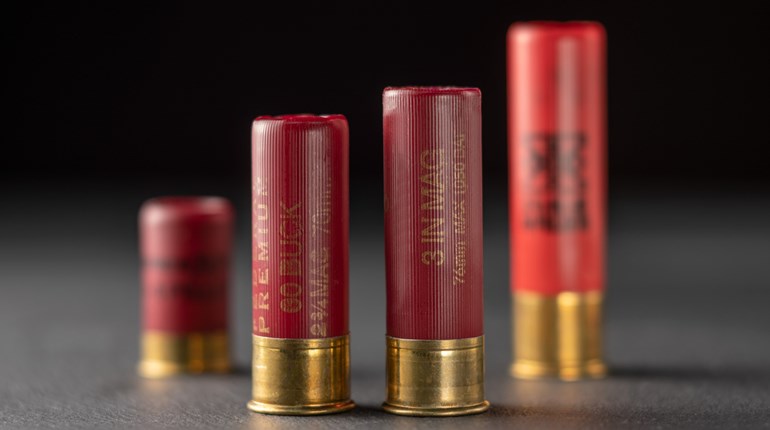
There’s a bit of a debate over the best stance for defensive shotgunning. Before you take a snooze cruise on this, realize that stance is much more important than in handgun and carbine disciplines due to the shotgun’s recoil that can shove you off balance and out of position after one shot. The two main techniques are the tactical/combat stance taught by military guys, and a hybrid, bladed stance adapted by 3-gunners. Military gurus typically say 3-gunners are adept at competition, but not combat, while 3-gunners say military guys are too slow in their dogmatic, rifle-like approach. I’ll discuss both so you can decide what’s best for you.
Mike Lamb is a former Force Recon Marine and instructor at Stoic Ventures. In his many YouTube videos he coaches the merits of a squared combat stance—feet in a standard isosceles stance, shoulder-width apart, shoulders square to the target. He says the buttpad should be placed inside of the shoulder pocket, a bit closer to the sternum so recoil is sent straight back so he can absorb it and get back on target.

Weight on the balls of his feet, leaning forward, he keeps his right (strong-side) elbow in to minimize his profile and his support hand extended far out on the fore-end. He advocates a short, 12.5-inch stock because of the position it is kept on his chest and because it’s easier to wield. In essence, it’s the same shooting position practice for tactical carbine in CQB situations.
“[This stance] lets me quickly present to target without taking a certain stance. I just drive the gun to the target regardless of where my legs are,” says Lamb.
Lamb is certainly convincing. But, he also weighs about 250 pounds and can benchpress several Jeff Johnstons. He can soak up serious recoil and not be shoved backward by it, even with his feet square. He’s also trained to attack targets by going toward them, all with body armor, something the typical home defender probably shouldn’t do. Lastly, his placement of the buttstock nearer the middle of the chest changes the stock’s relationship with the cheek and eye. In most cases it necessitates an optic or taller sights due to the difficulty of getting the head down so the eye aligns with the barrel’s rib. Still, to hear Lamb explain it is convincing.
Dave Starin, an instructor at Gunsite Academy, is also an advocate of the shoulders-squared stance. He says shotgunners should assume their natural fighting stance. For most people, this means that the strong-side foot staggered slightly behind the weak-side foot. He advocates placing the buttstock in the shoulder pocket, and strongly suggests a slightly shortened stock works best. Leaning in is critical. Starin has trained scores of women and smaller shooters who do just fine with this stance.
Jeff Cramblit is a professional 3-gun competitor with mad shotty skills. He disagrees with the squared stance and advocates one where the shoulders are bladed so he can point and shoot the shotgun instinctively as it was designed. He likes a full-size stock.
“A normal, quartering, weight-forward, bent-knee stance is what I and every other top [competitor] use.” When asked whether one stance presents a smaller target to a threat than the other, he said: “I prefer to shoot fast and accurately and not be shot.”

“Gunfighting isn’t about flat-out speed; it’s about perceiving, assessing and acting in a manner more efficient than your opponent,” retorts Lamb.
Starin concurs. He says gunfighting is more than just shooting; a squared stance is better when clearing a home where you may have to punch, kick, run, or whatever.
Now, if it were simple, I’d leave it at that. Competition is not gunfighting, so listen to the guys who teach gunfighting. But, there are plenty of guys—who happen to be the best guys in the world with shotguns—who also use their slick competitive tactics for defensive purposes.
Tate Moots is a 25-year law-enforcement veteran and professional 3-gunner. He also works for a protection agency of military-trained professional gunfighters. “Shoulder the shotgun the way it was designed,” Moots says, “and lean into it.” If you watch him you’ll see he shoots more like Cramblit with bladed shoulders and a staggered stance. Moots is frighteningly good in competition where speed, accuracy and transitional movement to and from cover is the game—skills that are the basis of home-defense tactics.
So, what stance should you use?
For the majority of home defenders, Starin’s fighting stance (feet slightly staggered, shoulders more or less square) is likely best because it promotes good balance, is relatively easy to learn and can be used interchangeably with a carbine. If you like it, you’ll like it more with a short stock.
But, I believe the bladed, 3-gun stance has the potential to be superior if practiced until it is mastered. Swift and accurate shooting should become as instinctive as pointing your finger. Then the shotgun needn’t be aimed to the extent of a handgun (just paste the front bead on target and worry not about a rear sight) so buckshot can be placed on multiple targets as fast as the eye can find them. While it’s tough for rifle guys to understand, when close-range targets move swiftly, point-shooting with the shotgun is superior to aiming with sights.
That’s because shotgunners who shoot it as designed (bladed, staggered stance) have the advantage of a properly fitting gun that contains multiple references for “aiming,” including cheek weld, buttstock, barrel rib and fore-end that ensure proper sight alignment by merely mounting it. While it’s possible to miss with a shotgun—we all know the pattern is mere inches wide at hallway distances—those who have mastered it don’t often miss. And if you aren’t going to master the shotgun, I strongly suggest using a rifle.




































